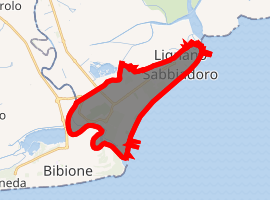Lignano Sabbiadoro
Lignano Sabbiadoro (Italian: [liɲˈɲaːno sabbjaˈdɔːro]; Friulian: Lignan) is a town and comune within the province of Udine, in the Friuli Venezia Giulia region of north-eastern Italy. It is one of the main summer resorts in northern Italy and on the Adriatic Sea coast.
Lignano Sabbiadoro | |
|---|---|
| Città di Lignano Sabbiadoro | |
Fountain of Viale Gorizia | |
 Coat of arms | |
Location of Lignano Sabbiadoro 
| |
 Lignano Sabbiadoro Location of Lignano Sabbiadoro in Italy  Lignano Sabbiadoro Lignano Sabbiadoro (Friuli-Venezia Giulia) | |
| Coordinates: 45°41′N 13°07′E | |
| Country | Italy |
| Region | Friuli-Venezia Giulia |
| Province | Udine (UD) |
| Government | |
| • Mayor | Luca Fanotto (UdC) |
| Area | |
| • Total | 16.21 km2 (6.26 sq mi) |
| Elevation | 2 m (7 ft) |
| Population (30 September 2017)[2] | |
| • Total | 6,962 |
| • Density | 430/km2 (1,100/sq mi) |
| Demonym(s) | Lignanesi |
| Time zone | UTC+1 (CET) |
| • Summer (DST) | UTC+2 (CEST) |
| Postal code | 33054 |
| Dialing code | 0431 |
| Patron saint | St. John Bosco |
| Saint day | 31 January |
| Website | Official website |

History
Lignano Sabbiadoro developed in the early 20th century from some hospitality resorts, which at the beginning could be reached only by sea. The first inhabitants came in 1931, after the draining of the nearby marshes. The first road connecting Lignano with the nearby comune of Latisana was built in 1926.
Formerly known as simply Lignano, the name Sabbiadoro (from sabbia d'oro "golden sand") was added in 1935 for promotional reasons.
It is divided into three zones, each with its own particular traits: the historic centre, rife with shops and restaurants (Lignano Sabbiadoro itself); the greener area of Lignano Pineta, with lovely gardens and lanes for strolling; and Lignano Riviera, the waterfront, rich in salty sea air and coastal pines.
During World War II, the very last operations of the German navy - involving the evacuation of troops and personnel from Istria and Trieste ahead the advancing Yugoslavs - took place here in May 1945. An estimated enemy force of 4000 landed from 26 ships of all types at the mouth of the Tagliamento River. Germans equipment included E-boats, LSTs, a small hospital ship, all types of transport, and a variety of weapons. The 21st Battalion of the New Zealand 2nd Division was outnumbered by 20 to one, but at the end, on 4 May 1945, the Germans surrendered. Lignano became an autonomous commune in 1959. Lignano lives on summertime tourism, and is home to Austrian, German, and Slovenian citizens.
In the late 2010s to early 2020s the town gained popularity on the Internet because of the satirical YouTube channel Cartoni Morti starring the recurring character of "il Sindaco di Lignano" ("the Mayor of Lignano").
Terrazza a Mare
The Terrazza a Mare (Italian: [terˈrattsa a ˈmaːre] "terrace on the sea" in English) of Lignano Sabbiadoro was designed by the architect Aldo Bernardis in 1969 and opened in 1972. It replaced the previous building designed by the architect Valle. It is considered to be one of the most important monuments of the city, housing shops, bar, and a solarium.
Marina and dock
The mooring complex (marina) of Lignano is the largest in Italy and among the largest in Europe, having more than 5,000 berths. The various structures of Aprilia Marittima, the harbour Marina Punta Faro, and the docks Porto Vecchio, Marina Uno, and Marina Punta Verde, are strategically positioned around the peninsula of Lignano, from the Marano lagoon to the river Tagliamento.
People
- Giorgio Scerbanenco (1911–1969), crime writer
- Massimiliano Esposito (1972) , football player and beach soccer player
See also
| Wikimedia Commons has media related to Lignano Sabbiadoro. |
References
- "Superficie di Comuni Province e Regioni italiane al 9 ottobre 2011". Istat. Retrieved 16 March 2019.
- "Popolazione Residente al 1° Gennaio 2018". Istat. Retrieved 16 March 2019.
External links
| Wikivoyage has a travel guide for Lignano. |
- Official website (in Italian)
- Messaggero Veneto - Giorgio Scerbanenco (in Italian)
